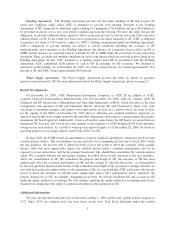AMD 2009 Annual Report Download - page 21
Download and view the complete annual report
Please find page 21 of the 2009 AMD annual report below. You can navigate through the pages in the report by either clicking on the pages listed below, or by using the keyword search tool below to find specific information within the annual report.software and hardware compatibility and stability, brand recognition, timely product introductions and
availability. Technological advances in the industry result in frequent product introductions, regular price
reductions, short product life cycles and increased product capabilities that may result in significant performance
improvements. Our ability to compete depends on our ability to develop, introduce and sell new products or
enhanced versions of existing products on a timely basis and at competitive prices, while reducing our costs.
Competition in the Microprocessor Market
Intel Corporation has dominated the market for microprocessors for many years. Intel’s market power and
significant financial resources enable it to market its products aggressively, to target our customers and our
channel partners with special incentives and to discipline customers who do business with us. These aggressive
activities have in the past and are likely in the future to result in lower unit sales and a lower average selling price
for our products, and adversely affect our margins and profitability.
Intel exerts substantial influence over computer manufacturers and their channels of distribution through
various brand and marketing programs. Because of its dominant position in the microprocessor market, Intel has
been able to control x86 microprocessor and computer system standards and to dictate the type of products the
microprocessor market requires of us. Intel also dominates the computer system platform, which includes core
logic chipsets, integrated graphics chips, motherboards and other components necessary to assemble a computer
system. As a result, OEMs that purchase microprocessors for computer systems are highly dependent on Intel,
less innovative on their own and, in some cases, are essentially distributors of Intel technology. Additionally,
Intel is able to drive de facto standards for x86 microprocessors that could cause us and other companies to have
delayed access to such standards.
As long as Intel remains in this dominant position, we may be materially adversely affected by Intel’s:
• business practices, including rebating, and allocation strategies and pricing actions, designed to limit
our market share;
• product mix and introduction schedules;
• product bundling, marketing and merchandising strategies;
• exclusivity payments to its current and potential customers;
• control over industry standards, PC manufacturers and other PC industry participants, including
motherboard, memory, chipset and basic input/output system, or BIOS, suppliers and software
companies as well as the graphics interface for Intel platforms; and
• marketing and advertising expenditures in support of positioning the Intel brand over the brand of its
OEM customers.
Intel has substantially greater financial resources than we do and accordingly spends substantially greater
amounts on research and development and production capacity than we do. We expect Intel to maintain its
dominant position and to continue to invest heavily in marketing, research and development, new manufacturing
facilities and other technology companies. To the extent Intel manufactures a significantly larger portion of its
microprocessor products using more advanced process technologies, or introduces competitive new products into
the market before we do, we may be more vulnerable to Intel’s aggressive marketing and pricing strategies for
microprocessor products. For example, Intel is transitioning to 32 nm process technology before us. Using more
advanced process technology can contribute to lower product manufacturing costs and improve a product’s
performance and power efficiency. We expect intense competition from Intel to continue.
In November 2009, Intel and AMD announced a comprehensive agreement to end all outstanding legal
disputes between the companies, including antitrust litigation and patent cross license disputes. Under terms of
the agreement, AMD and Intel obtain patent rights from a new 5-year cross license agreement, Intel and AMD
13
























